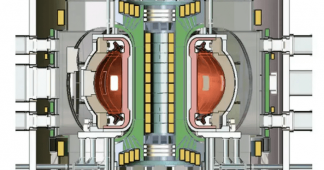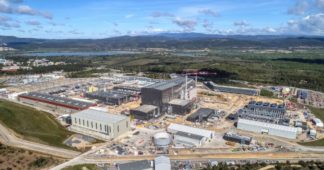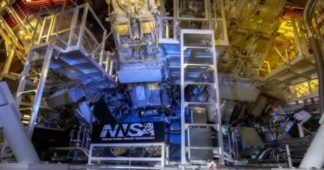Despite the hype, we shouldn’t bank on nuclear fusion to save the world from climate catastrophe
By Robin McKie
Dec 17, 2022
The revelation that researchers had succeeded in creating a nuclear fusion reaction that generated more energy than it consumed made reassuring reading last week. For almost half a century, I have reported on scientific issues and no decade has been complete without two or three announcements by scientists claiming their work would soon allow science to recreate the processes that drive the sun. The end result would be the generation of clean, cheap nuclear fusion that would transform our lives.
Such announcements have been rare recently, so it gave me a warm glow to realise that standards may be returning to normal. By deploying a set of 192 lasers to bombard pellets of the hydrogen isotopes deuterium and tritium, researchers at the US National Ignition Facility (NIF) in Livermore, California, were able to generate temperatures only found in stars and thermonuclear bombs. The isotopes then fused into helium, releasing excess energy, they reported.
Continue reading at www.theguardian.com
Exaggerated fusion breakthrough is for military purposes
The claims for a breakthrough in fusion power are not only exaggerated but in reality concerned principally with military objectives.
This test, carried out by the National Ignition Facility at US Government’s Lawrence Livermore National Laboratory (LLNL), was mainly to facilitate the testing of nuclear weapons. This fact was missed in almost all the hyperbole surrounding the test.
Continue reading at 100percentrenewableuk.org
The Energy Department’s fusion breakthrough: It’s not really about generating electricity
By John Mecklin
December 16, 2022
This week’s headlines have been full of reports about a “major breakthrough” in nuclear fusion technology that, many of those reports misleadingly suggested, augurs a future of abundant clean energy produced by fusion nuclear power plants. To be sure, many of those reports lightly hedged their enthusiasm by noting that (as The Guardian put it) “major hurdles” to a fusion-powered world remain.
Indeed, they do.
The fusion achievement that the US Energy Department announced this week is scientifically significant, but the significance does not relate primarily to electricity generation. Researchers at Lawrence Livermore National Laboratory’s National Ignition Facility, or NIF, focused the facility’s 192 lasers on a target containing a small capsule of deuterium–tritium fuel, compressing it and inducing what is known as ignition.
Continue reading at thebulletin.org
Fusion Energy Breakthrough Scam
By Steven B. Krivit
Dec. 11, 2022
Financial Times, among others, reported Sunday “Fusion energy breakthrough by US scientists boosts clean power hopes. Net energy gain indicates technology could provide an abundant zero-carbon alternative to fossil fuels.”
Scientifically, the National Ignition Facility result is relevant and honest. But the exaggeration and misrepresentation of the result is not.
Omar A. Hurricane, chief scientist for the inertial confinement fusion program at the NIF lab, explained the facts to New Energy Times
Continue reading at news.newenergytimes.net
U.S. Project Reaches Major Milestone toward Practical Fusion Power
By Philip Ball
Nuclear fusion could potentially provide abundant, safe energy without the significant production of greenhouse gas emissions or nuclear waste. But it has remained frustratingly elusive as a practical technology for decades. An important milestone toward that goal has now been passed: a fusion reaction that derives most of its heat from its nuclear reactions themselves rather than the energy pumped into the fuel from outside.
A team at the National Ignition Facility (NIF) at Lawrence Livermore National Laboratory (LLNL) in California has reported this so-called burning plasma condition using an approach called inertial-confinement fusion, where the ferociously high temperatures and pressures needed to initiate fusion in a fuel of hydrogen isotopes are produced by intense pulses of laser light.
Continue reading at www.scientificamerican.com
The Theranos Trial Shows Why We Should Be Suspicious of Nuclear Fusion
The Theranos story is an epic tale of folly with lots of twists and turns, but it’s by no means unique. At the very same moment the play-by-play of the Elizabeth Holmes trial sprawls across the drama section of your daily paper, the pages of the business section are filled with adulatory copy regarding other science-techy startups. Inevitably, some of them will end up with financial losses that are even bigger, thanks to technology that is even shakier, business models that are more delusional, and exaggerations that are nearly as bold as anything associated with Holmes’ fiction-enhanced blood-testing company. These “startups” all promise limitless clean energy: power from nuclear fusion and a rapid transformation of our energy supply away from fossil fuels.
Continue reading at slate.com
Out of gas
By Daniel Clery
23 Jun 2022
In 2020, Canadian Nuclear Laboratories delivered five steel drums, lined with cork to absorb shocks, to the Joint European Torus (JET), a large fusion reactor in the United Kingdom. Inside each drum was a steel cylinder the size of a Coke can, holding a wisp of hydrogen gas—just 10 grams of it, or the weight of a couple sheets of paper.
This wasn’t ordinary hydrogen but its rare radioactive isotope tritium, in which two neutrons and a proton cling together in the nucleus. At $30,000 per gram, it’s almost as precious as a diamond, but for fusion researchers the price is worth paying. When tritium is combined at high temperatures with its sibling deuterium, the two gases can burn like the Sun. The reaction could provide abundant clean energy—just as soon as fusion scientists figure out how to efficiently spark it.
Continue reading at www.science.org
We remind our readers that publication of articles on our site does not mean that we agree with what is written. Our policy is to publish anything which we consider of interest, so as to assist our readers in forming their opinions. Sometimes we even publish articles with which we totally disagree, since we believe it is important for our readers to be informed on as wide a spectrum of views as possible.











